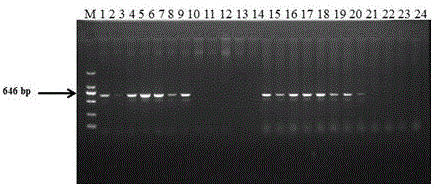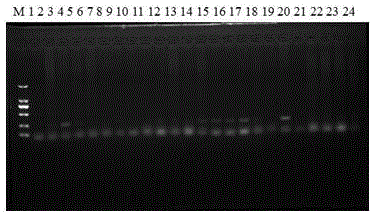Primer, kit and method for identifying dove sex
A kit, pigeon technology, applied in biochemical equipment and methods, microbial determination/inspection, DNA/RNA fragments, etc., can solve problems such as insufficient specificity and false negatives, and achieve good specificity, high recognition, high resolution effect
- Summary
- Abstract
- Description
- Claims
- Application Information
AI Technical Summary
Problems solved by technology
Method used
Image
Examples
Embodiment 1
[0041] Example 1 Primer design and specificity experiments
[0042]Venous blood sample processing method: Take 5 microliters of blood with a pipette in the early stage, and dilute it into tube A containing blood sample lysate according to the volume ratio of 1:30.
[0043] Blood sample processing method in feather follicles: Press the newly picked feathers along the feathers to the hair bulb to collect 10 microliters or more of fresh blood, and add 150 microliters of blood sample lysate.
[0044] Feather sample processing method: cut the collected feathers along the root to 3-4 mm, place in tube B containing 150 microliters of feather sample lysate, and place at room temperature for 2 minutes.
[0045] The PCR amplification procedure is as follows:
[0046] (1) According to the preset program in the PCR machine, heat at 98°C for 10 minutes, then cool at 4°C for ten minutes, take out tube A or tube B, 1.2×10 4 centrifuge for 10 minutes.
[0047] (2) Transfer the supernatant...
Embodiment 2
[0055] Example 2 Lysate Screening Experiment (Blood Sample)
[0056] The sample processing method is the same as in Example 1 (blood sample is selected here), and the PCR amplification procedure is as follows:
[0057] (1) According to the preset program in the PCR machine, heat at 98°C for 10 minutes, then cool at 4°C for ten minutes, take out tube A or tube B, 1.2×10 4 centrifuge for 10 minutes.
[0058] (2) Transfer the supernatant in tube A or tube B to a new PCR tube, take 2 microliters as a template for the PCR reaction, and then add 10 microliters of PermixTaq in sequence TM, , 6 microliters of double-distilled water, and 1 microliter each of the upstream and downstream primers, totaling 20 microliters of the system (the sequences of the upstream and downstream primers are shown in SEQ ID NO: 1 and SEQ ID NO: 2).
[0059] SEQ ID NO: 1: 5'-TTCTGAGGATGGAAATGAGT-3'
[0060] SEQ ID NO: 2: 5'-AGCAATGGTTACAACACTTC-3'
Embodiment 3
[0067] Example 3 Lysate screening experiment (feather sample)
[0068] Pigeon feathers are rich in protein components, which brings great difficulty to effective amplification; we have explored a variety of feather-like lysates in the early stage, among which PBS buffer is very feasible as a feather-like lysate, The result of its amplification is as Figure 9 .
[0069] Next, the concentration of the experimental PBS buffer is the effect of the amplification result, the result is as follows Figure 10 , and finally determine 1×PBS as the lysate of pigeon feather samples. Using 1×PBS as the lysate, SEQ ID NO: 1 and SEQ ID NO: 2 as primers, verified with 30 male and female pigeons respectively, the results are as follows Figure 11 with 12 .
[0070] Depend on Figure 11 with Figure 12 We can know that after the feather samples are treated with 1×PBS, the PCR reaction and agarose gel electrophoresis can amplify the bands for distinguishing sex. but, Figure 12 The elec...
PUM
 Login to View More
Login to View More Abstract
Description
Claims
Application Information
 Login to View More
Login to View More - R&D
- Intellectual Property
- Life Sciences
- Materials
- Tech Scout
- Unparalleled Data Quality
- Higher Quality Content
- 60% Fewer Hallucinations
Browse by: Latest US Patents, China's latest patents, Technical Efficacy Thesaurus, Application Domain, Technology Topic, Popular Technical Reports.
© 2025 PatSnap. All rights reserved.Legal|Privacy policy|Modern Slavery Act Transparency Statement|Sitemap|About US| Contact US: help@patsnap.com



